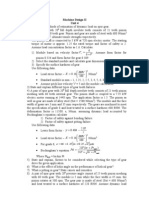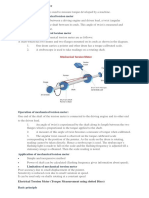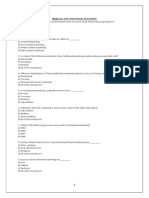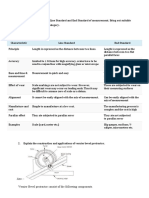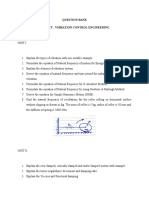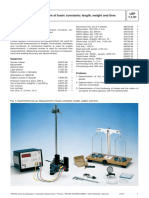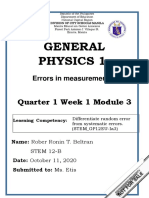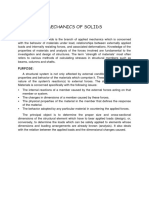75 Questions of Metrology
75 Questions of Metrology
Uploaded by
Vivek BajpaiCopyright:
Available Formats
75 Questions of Metrology
75 Questions of Metrology
Uploaded by
Vivek BajpaiOriginal Description:
Copyright
Available Formats
Share this document
Did you find this document useful?
Is this content inappropriate?
Copyright:
Available Formats
75 Questions of Metrology
75 Questions of Metrology
Uploaded by
Vivek BajpaiCopyright:
Available Formats
Krishna Engineering College, Ghaziabad
Department of mechanical Engineering
75 Interview Questions of Metrology
1. What are measurement standards?
Ans. Standards are objects of known size, quantity, roughness, etc. These standards are used to
calibrate and verify measuring instruments. As a result, measured values are more accurate.
2. What effect will temperature variation have on precision measurements?
Ans. Temperature control during measurement is important because as materials are heated they
expand. Each material expands at a different rate. This leads to distortion of parts and measuring
devices that results in measurement errors.
3. How can a vernier scale provide higher accuracy?
Ans. A vernier scale uses a second elongated scale to interpolate values on a major scale.
4. What are dimensional tolerances, and what are their primary uses?
Ans. Dimensional tolerances specify the amount a dimension may vary about a target value.
These are supplied by a designer to ensure the correct function of a device. If these tolerances are
controlled the final product will work as planned.
5. Why is an allowance different from a tolerance?
Ans. A tolerance is the amount a single dimension can vary. An allowance is an intentional
difference between two dimensions to allow for press fits, running fits, etc.
6. What are fits?
Ans. There are standard for different types of fits (e.g. press fit, running clearance). These specify
the allowance of two parts, so that they may be made separately and then joined (mated) in an
assembly.
7. What is the difference between precision and accuracy?
Ans. Precision suggests a limit of technology, accuracy is the ability to achieve a value
consistently. These are often interchanged because we are usually concerned with the accuracy
when producing precision parts.
8. Why are different grades of gauge blocks used?
Ans. There are different quality levels for gauges blocks. The poorest sets are workshop grade and
are more accurate than most machine tools. The best sets are very accurate, and must be kept in
tightly controlled conditions. The best sets are used for calibrating others.
9. How are a ring gauge and a plug gauge different?
Ans. A plug gauge goes into a hole, a ring gauge surrounds a dimension.
10. Why is a micrometer used for precise measurement of components in mechanical
engineering.
Satyajeet Singh, Asst.Professor, Krishna Engineering College 1
Ans : Digital calipers are pretty accurate, but if you need precision, a micrometer is the way to go.
Some things need to be measured in 1/10000ths of an inch (e.g. high pressure hydraulic pump
pistons) and a digital caliper just won’t do that. That said, I use calipers all the time and use a mic
when I need to.
11. How are pressure gauges specified?
Ans : There are a number of things to take into account while specifying the right pressure gauge
for your application. This goes from choosing the right measuring range, choosing the diameter of
the dial, to preventing the pressure gauge from being subject to vibrations and even more of this
kind of choices.
12. What is Range of measurement?
The physical variables that are measured between two values. One is the higher calibration
value H, and the other is Lower value L, The difference between H, and L, is called range.
13. What is Resolution?
The minimum value of the input signal is required to cause an appreciable change in the
output known as resolution.
14. Differentiate between sensitivity and range with suitable example.
Example: An Instrument has a scale reading of 0.01 mm to 100 mm. Here, the sensitivity of
the instrument is 0.01 mm i.e. the minimum value in the scale by which the instrument can
read. The range is 0.01 to 100 mm i.e. the minimum to maximum value by which the
instrument can read.
15. Define system error and correction.
Error: The deviation between the results of measured value to the actual value.
Correction: The numerical value which should be added to the measured value to get the
correct result.
16. Define: Measurement.
Measuring is the physical quantity or property like length, diameter, and angle to be
measured.
17. Define: Deterministic Metrology.
The metrology in which part measurement is replaced by process measurement. The new
techniques such as 3D error compensation by CNC systems are applied.
18. Give any four methods of measurement
1. Direct method.
2. Indirect method.
3. Comparison method.
4. Coincidence method.
19. Give classification of measuring instruments.
1. Angle measuring Instruments.
2. Length measuring Instruments.
3. Instruments for surface finish.
4. Instruments for deviations.
20. Define True size.
True size is Theoretical size of a dimension.
21. Define Actual size.
Actual size = Size obtained through measurement with permissible error.
Satyajeet Singh, Asst.Professor, Krishna Engineering College 2
22. What is Hysteresis?
All the energy put into the stressed component when loaded is not recovered upon unloading.
So, the output of measurement partially depends on input called hysteresis.
23. Differentiate accuracy and Uncertainty with example.
o Accuracy – Closeness to the true value.
o Example: Measuring accuracy is ± 0.02mm for diameter 25mm.
o Here the measurement true values lie between 24.98 to25.02 mm
o Uncertainty about the true value = ± 0.02mm
24. Define Span.
The algebraic difference between higher calibration values to lower calibration value.
Example: In a measurement of temperature higher value is 200*C and lower value is 15000 C
means span = 200 – 150 = 500 C.
25. Differentiate between precision and accuracy.
Accuracy – The maximum amount by which the result differ from true value.
Precision – Degree of repetitiveness. If an instrument is not precise it will give different
results for the same dimension for the repeated readings.
26. What is Scale interval?
It is the difference between two successive scale marks in units.
27. What is Response Time?
The time at which the instrument begins its response for a change measured quantity.
28. Define Repeatability.
The ability of the measuring instrument to repeat the same results g the act measurements
for the same quantity is known as repeatability.
29. Explain the term magnification.
It means the magnitude of output signal of measuring instrument time’s increases to make it
more readable.
30. Classify the Absolute error.
The absolute error is classified into
1. True absolute error.
2. Apparent absolute error.
31. What is Relative error?
Relative error is defined as the results of the absolute error and the, value of comparison used
for calculation of that absolute error. The comparison may be true value or conventional true
value or arithmetic mean for series of measurement.
32. Classify the errors.
The errors can be classified into
1. Static errors – Reading errors
– Characteristic errors,
– Environmental errors
2. Loading errors
3. Dynamic error.
33. What is the basic Principle of measurement?
It is the physical phenomenon utilized in the measurement. If energy kind of quantity
measured, there must be a unit to measure it. So this will give the quantity to be measured in
number of that unit.
34. What is Application of Legal Metrology ?
Satyajeet Singh, Asst.Professor, Krishna Engineering College 3
1. Industrial Measurements.
2. Commercial transactions.
3. Public health and human safety ensuring.
35. What is the need of inspection?
To determine the fitness of new made materials, products or component part and to compare
the materials, products to the established standard.
36. What are the important elements of measurements?
The important elements of a measurement is
1. Measurand.
2. Reference.
3. Comparator.
37. What are the considerations while manufacturing the slip gauges?
The following additional operations are carried out to obtain the necessary qualities in slip gauges
during manufacture.
1. First the approximate size of slip gauges is done by preliminary operations.
2. The blocks are hardened and wear resistant by a special heat treatment process.
3. To stabilize the whole life of blocks, seasoning process is done.
4. The approximate required dimension is done by a final grinding process.
38. How do you calibrate the slip gauges?
Comparators are used to calibrate the slip gauges.
39. List the various linear measurements?
(i) Length.
(ii) Heights and
(iii) Thickness.
40. What are the various types of linear measuring instruments?
The various devices used for measuring the linear measurements are
i. Vernier calipers.
ii. Micrometers.
iii. Slip gauge or gauge blocks.
iv. Comparator.
41. List out any four angular measuring instrument used in metrology.
(i) Angle gauges.
(ii) Divided scales.
(iii) Sine bar with slip gauges.
(iv) Autocollimator.
(v) Angle dekkor.
42. Classify the comparator according to the principles used for obtaining magnification.
The common types are:
(i) Mechanical comparators.
(ii) Electrical comparators.
(iii) Optical comparators.
(iv) Pneumatic comparators.
43. What are comparators?
Comparators are one form of linear measurement device which is quick and more convenient
for checking large number of identical dimensions.
44. How the mechanical comparator works?
Satyajeet Singh, Asst.Professor, Krishna Engineering College 4
The method of magnifying small movement of the indicator in all mechanical comparators are
effected by means of levers, gear trains or a combination of these elements.
45. State the best example of a mechanical comparator.
A dial indicator or dial gauge is used as a mechanical comparator.
46. Define least count and mention the least count of a mechanical comparator.
Least count. – The least value that can be measured by using any measuring instrument
known as least count. Least count of a mechanical comparator is 0.0 1 mm.
47. How the mechanical comparator is used? State with any one example.
Let us assume that the required height of the component I s 32.5mm. Initially, this height is
built up with slip gauges. The slip gauge blocks are placed under the stem of the dial gauge.
The pointer in the dial gauge is adjusted to zero. The slip gauges are removed- Now, the
component to be checked is introduced under the stem of the dial gauge. If there is any
deviation in the height of the component, it will be indicated by the pointer.
48. State any four advantages of reed type mechanical comparator.
(i) It is usually robust, compact and easy to handle.
(ii) There is no external supply such as electricity, air required.
(iii) It has very simple mechanism and is cheaper when compared to other types.
(iv) It is suitable for ordinary workshop and also easily portable.
49. Mention any two disadvantages of reed type mechanical comparator.
(i) Accuracy of the comparator mainly depends on the accuracy of the rack and pinion
arrangement. Any slackness will reduce accuracy.
(ii) It has more moving parts and hence friction is more and accuracy is less.
50. What are the major types of on electrical comparator?
An electrical comparator consists of the following three major parts such as
(i) Transducer.
(ii) Display device as meter.
(iii) Amplifier.
51. On what basis the transducer works?
An iron armature is provided in between two coils held by a leaf spring at one end. The other
end is supported against a plunger. The two coils act as two arms of an A.C. wheat stone
bridge circuit.
52. How is the accuracy of an electrical comparator checked?
To check the accuracy of a given specimen or work, first a standard specimen is placed under
the plunger. After this, the resistance of wheat stone bridge is adjusted that the scale reading
shows zero. Then the specimen is removed. Now, the work is introduced under the plunger.
53. State the working principle of an electronic comparator.
In electronic comparator, transducer induction or the principle of application of
frequency modulation or radio oscillation is followed.
54. Mention the important parts of an electronic comparator.
(i) Transducer. (iv) Demodulator.
(ii) Oscillator. (v) Meter.
(iii) Amplifier.
55. Classify pneumatic comparators.
(i) Flow or Velocity type.
(ii) Back pressure type.
56. What are the advantages of electrical and electronic comparator?
Satyajeet Singh, Asst.Professor, Krishna Engineering College 5
(i) It has less number of moving parts.
(ii) Magnification obtained is very high.
(iii) Two or more magnifications are provided in the same instrument to use various
ranges.
(iv) The pointer is made very light so that it ‘IS more sensitive to vibration.
57 . What are the disadvantages of electrical and electronic comparator?
(i) External agency is required to meter for actuation.
(ii) Variation of voltage or frequency may affect the accuracy of output.
(iv) Due to heating coils, the accuracy decreases.
(v) It is more expensive than mechanical comparator.
58. List the various parts of an optical comparator.
The optical comparator consists of the following parts such as
(i) Pivoted lever. (iv) Plunger.
(ii) Objective lens (iv) Table
(iii) Scale. (v) Base.
59. What are the advantages of pneumatic comparators?
(i) The wear of measuring heads is avoided due to absence of direct contact.
(ii) Friction is less due to less number of moving parts.
(iii) Work piece is cleaned by supplying of all during the measurement.
(iv)High magnification is possible.
(v) There is no interference of measuring head and indicating device because the
measuring head is kept away from the indicating device.
(vi) It is a suitable method to check taperness of circular bore.
60. Explain briefly the three important fields of machine vision system?
Inspection: it is the ability of an automated vision system to recognize well-defined
pattern and if these pattern match these stored in the system makes machine vision ideal
for inspection of raw materials, parts, assemblies etc.
Part identification: It is the ability of part recognition provides positive identifications
of an object for decision-making purposes. Guidance and Control. Machine vision
systems are used to provide sensor feedback for real time guidance.
61. What is interferometer?
Interferometer is optical instruments used for measuring flatness and determining the
lengths of slip gauges by direct reference to the wavelength of light.
62. Name the different types of interferometer?
1) NPL flatness interferometer.
2) Michelson interferometer.
3) Laser interferometer.
4) Zesis gauge block interferometer.
63.Name the common source of light used for interferometer?
a. Mercury 198. d. Helium.
b. Cad minus. e. Hydrogen.
c. Krypton 86.
64. What is crest and trough?
Satyajeet Singh, Asst.Professor, Krishna Engineering College 6
The light is a form of energy being propagated by electromagnetic waves, which is a sine
curve. The high point of the wave is called crust and the low Point is called is trough.
65. What is meant by alignment test on machine tools?
The alignment test is carried out to check the grade of manufacturing accuracy of the
machine tool.
66. List the various geometrical checks made on machine tools.
a. Straightness of guide ways and slide ways of machine tool.
b. Flatness of machine tables and slide ways.
c. Parallelism, equidistance and alignment of the slide ways.
d. True running and alignment of shaft and spindle.
e. The pitch error or lead of lead screw.
f. Pitch errors of gears.
67. What is wavelength?
The distance between two crusts or two rough is called the wavelength.
68. Distinguish between geometrical test and practical test on a machine tool.
The alignment test is carried out to check the grade of manufacturing accuracy of the
machine tool. Performance test consist of checking the accuracy of the finished
component. Alignment test consist of checking the relationship between various machine
elements when the machine tool is idle. Performance test consists of preparing the actual
test jobs on the machine and checking the accuracy of the jobs produced.
69. What are the main spindle errors?
a) Out of round. d) Run out.
b) Eccentricity. e) Periodical axial slip.
c) Radial throws of an axis.
70. Write the various tests conducted on any machine tools?
1. Test for level of installation of machine tool in horizontal and vertical planes.
2. Test for flatness of machine bed and for straightness and parallelism of bed ways on
bearing surface.
3. Test for perpendicularity of guide ways to other guide ways.
4. Test for true running of the main spindle and its axial movements.
71. Why the laser is used in alignment testing?
The alignment tests can be carried out over greater distances and to a greater degree of
accuracy using laser equipment. Laser equipment produces real straight line, whereas an
alignment telescope provides a, imaginary line that cannot be seen in space.
72. Classify the machine tool test.
It can be classified into
1. Static tests.
2. Dynamic tests.
73. What are the different types of geometrical tests conducted on machine tools?
1. Straightness.
2. Flatness.
3. Parallelism, equi-distance and coincidence.
74. Why Hole Basis Systems are Preferred?
Holes can be finished by tools like reamers, drills, broaches, and their sizes are not
adjustable. The shaft sizes can be easily obtained by external machining.
Satyajeet Singh, Asst.Professor, Krishna Engineering College 7
If shaft basis system is used considerable no of reamers and other precision tools are
required for producing different classes of holes for one class of shaft for obtaining
different fits which increases cost of production.
It is economical
75.Why is a unilateral tolerance preferred over bilateral tolerance?
This system is preferred for Interchangeable manufacturing.
It is easy and simple to determine deviations.
It helps standardize the GO gauge end .
Helpful for operator because he has to machine the upper limit of the shaft and the lower
limit of the hole knowing fully well that still some margin is left for machining before the
part is rejected.
Satyajeet Singh, Asst.Professor, Krishna Engineering College 8
You might also like
- Thermal Engineering (ME 2301) 2 Mark Question and Answers PDFDocument10 pagesThermal Engineering (ME 2301) 2 Mark Question and Answers PDFA.R. Pradeep Kumar89% (9)
- Machine Drawing-Short Answer QuestionsDocument3 pagesMachine Drawing-Short Answer Questionsfatehjitsingh100% (1)
- Engg Graphics Viva Question AnswersDocument12 pagesEngg Graphics Viva Question AnswersaswinNo ratings yet
- Line and End StandardDocument1 pageLine and End StandardAmolNo ratings yet
- HMT 2mark With AnswerDocument13 pagesHMT 2mark With AnswerERKATHIR71% (7)
- Automotive 8 ExamDocument3 pagesAutomotive 8 ExamMr-Butay Intano100% (1)
- 2.calibration of Vernier Height Gauge, Vernier Depth Gauge Measurements Metrology MeasurementLab - ME594Document5 pages2.calibration of Vernier Height Gauge, Vernier Depth Gauge Measurements Metrology MeasurementLab - ME594said3232100% (2)
- Eti Ohe 76 - 6 97 - PDFDocument16 pagesEti Ohe 76 - 6 97 - PDFCounter RoverNo ratings yet
- Engineering Metrology 2 MarksDocument13 pagesEngineering Metrology 2 MarksRavi SivaprakashNo ratings yet
- Engineering Metrology and Measurement - 2 Marks - All 5 UnitsDocument21 pagesEngineering Metrology and Measurement - 2 Marks - All 5 UnitsMohan Prasad.M92% (13)
- Me3592-Metrology Andmeasurements-1020725174-Me3592-Mm All Units NotesDocument78 pagesMe3592-Metrology Andmeasurements-1020725174-Me3592-Mm All Units NotesANNAMALAINo ratings yet
- Metrology Viva QuestionsDocument4 pagesMetrology Viva Questionsyadasri90% (10)
- Experimental Stress Analysis Two Marks With AnswersDocument24 pagesExperimental Stress Analysis Two Marks With Answersmatrixrajiv34100% (2)
- Important Questions MetrologyDocument5 pagesImportant Questions Metrologyswathi_ipe100% (1)
- CAD CAM Viva QuestionsDocument3 pagesCAD CAM Viva QuestionsTheja Sree100% (3)
- Principle and Operation of Stylus and Probe InstrumentsDocument19 pagesPrinciple and Operation of Stylus and Probe InstrumentsSatyam Singh100% (5)
- Cad Cam Lab VivaDocument9 pagesCad Cam Lab VivaAnonymous dYDY4Eha100% (2)
- Dynamics of Machinery GATE BitsDocument8 pagesDynamics of Machinery GATE BitsVenkateswar Reddy MallepallyNo ratings yet
- 4.mechanical Measurements and MetrologyDocument6 pages4.mechanical Measurements and MetrologyVikram Rao100% (1)
- Study of Sine BarDocument6 pagesStudy of Sine BarMaria Mehar100% (2)
- Machine Design-II Question BankDocument9 pagesMachine Design-II Question BankProf. Avinash MahaleNo ratings yet
- Viva Voce Questions: CNC MachinesDocument4 pagesViva Voce Questions: CNC MachinesguruNo ratings yet
- CNC Technology 2 MarksDocument10 pagesCNC Technology 2 Markssivaeinfo0% (1)
- 100+ TOP MMT Lab Viva Questions and Answers MMT Viva QuestionsDocument2 pages100+ TOP MMT Lab Viva Questions and Answers MMT Viva QuestionsNikhil Prasanna100% (2)
- Production Lab Viva Question & AnswersDocument13 pagesProduction Lab Viva Question & AnswersPradeep Gs100% (1)
- Design of Transmission System Question BankDocument18 pagesDesign of Transmission System Question BankAravind50% (2)
- Computer Applications in DesignDocument7 pagesComputer Applications in Designmskumar_5540% (1)
- Two Marks Questions With AnswersDocument18 pagesTwo Marks Questions With AnswersSaravanan Mani100% (2)
- Design of Transmission System - 2 Marks - All 5 UnitsDocument20 pagesDesign of Transmission System - 2 Marks - All 5 UnitsMohan Prasad.M80% (15)
- HMT 2 Mark Question and AnswerDocument26 pagesHMT 2 Mark Question and AnswerRavikumar100% (1)
- Assigment 1 - SWIPEDocument2 pagesAssigment 1 - SWIPEMr-Mk MughalNo ratings yet
- MCQ Metrology (CCCM & CCCT) PDFDocument21 pagesMCQ Metrology (CCCM & CCCT) PDFSahil Gauhar67% (3)
- Mechanical Measurement and Control - Question BankDocument3 pagesMechanical Measurement and Control - Question BankPrithvi ManwaniNo ratings yet
- ED7102-Computer Applications in DesignDocument11 pagesED7102-Computer Applications in DesignLOGANTKEC100% (2)
- Dynamics of Machinery 2 Marks All 5 UnitsDocument14 pagesDynamics of Machinery 2 Marks All 5 UnitsDHINAKARANVEEMAN100% (2)
- 2D - TransformationDocument95 pages2D - TransformationShubhamNo ratings yet
- Unit II Curves & SurfacesDocument57 pagesUnit II Curves & Surfacesvishwajeet patilNo ratings yet
- MCQDocument9 pagesMCQAnjaneyulu Naik100% (2)
- Machine Drawing Two Mark QuestionsDocument13 pagesMachine Drawing Two Mark QuestionsHimanshuSisodiyaNo ratings yet
- METROLOGY AND QUALITY CONTROL LAB Manual PDFDocument28 pagesMETROLOGY AND QUALITY CONTROL LAB Manual PDFMuhammad zubeen100% (1)
- Ppce MCQDocument210 pagesPpce MCQjeevan ram vNo ratings yet
- ECM Process Parameter 1Document8 pagesECM Process Parameter 1K O100% (1)
- CIM Wheel and ModelDocument43 pagesCIM Wheel and ModelNathanael Aklilu Ejersa100% (2)
- Basic Principle of Mechanical Torsion MeterDocument4 pagesBasic Principle of Mechanical Torsion MeterKranthi KumarNo ratings yet
- MMEMD 106-3 Vibration Control and CMDocument2 pagesMMEMD 106-3 Vibration Control and CMPauloHornburgNo ratings yet
- AIP Lab Manual - 012110050524 - 1Document11 pagesAIP Lab Manual - 012110050524 - 1Martin De Boras PragashNo ratings yet
- Advance Manufacturing Processes MCQ S 1 PDFDocument18 pagesAdvance Manufacturing Processes MCQ S 1 PDFmhd slmnNo ratings yet
- Introduction To Mechanical Micro Machining Assignment-Week 8Document7 pagesIntroduction To Mechanical Micro Machining Assignment-Week 8PranjalGuptaNo ratings yet
- UNIT I 1.6 Group-TechnologyDocument78 pagesUNIT I 1.6 Group-Technologyprof_panneerNo ratings yet
- Thread and Gear MeasurementDocument142 pagesThread and Gear Measurementshiva100% (1)
- Question Bank On Comparator Chapter I. Fill in The BlanksDocument9 pagesQuestion Bank On Comparator Chapter I. Fill in The BlanksMohammed AseerNo ratings yet
- Mechatronics MCQDocument35 pagesMechatronics MCQmech mech189% (19)
- Differentiate Between Line Standard and End Standard of Measurement 1Document19 pagesDifferentiate Between Line Standard and End Standard of Measurement 1ghghgNo ratings yet
- Viva VoiceDocument6 pagesViva VoiceRakesh Kumar Shukla KECNo ratings yet
- Unit-3 Tolerance AnalysisDocument78 pagesUnit-3 Tolerance AnalysisMECH PEDIANo ratings yet
- Automated InspectionDocument31 pagesAutomated InspectionVijay Kumar100% (8)
- DYNAMICS LAB VIVA QUESTIONS FullDocument4 pagesDYNAMICS LAB VIVA QUESTIONS FullSudipta NathNo ratings yet
- Question Bank Subject: Vibration Control EngineeringDocument5 pagesQuestion Bank Subject: Vibration Control EngineeringOmNo ratings yet
- Projection of Planes Question Bank and SolutionsDocument6 pagesProjection of Planes Question Bank and SolutionsJay S Ja'Na33% (3)
- UNIT-IV Question BankDocument3 pagesUNIT-IV Question BankParamasivam VeerappanNo ratings yet
- Experiment No:-2: Aim: - ObjectiveDocument4 pagesExperiment No:-2: Aim: - ObjectiveExertion FallNo ratings yet
- Metrology and MeasurementsDocument15 pagesMetrology and MeasurementsUjjwal kecNo ratings yet
- Me2304 Emm PDFDocument13 pagesMe2304 Emm PDFvvnprabhuNo ratings yet
- Krishna Engineering College Department of Mechanical EngineeringDocument5 pagesKrishna Engineering College Department of Mechanical EngineeringVivek BajpaiNo ratings yet
- Krishna Engineering College Department of Mechanical EngineeringDocument4 pagesKrishna Engineering College Department of Mechanical EngineeringVivek BajpaiNo ratings yet
- Krishna Engineering College Department of Mechanical EngineeringDocument4 pagesKrishna Engineering College Department of Mechanical EngineeringVivek BajpaiNo ratings yet
- Powder Metallurgy: Basics & Applications Powder MetallurgyDocument11 pagesPowder Metallurgy: Basics & Applications Powder MetallurgyVivek BajpaiNo ratings yet
- Krishna Engineering College Department of Mechanical EngineeringDocument8 pagesKrishna Engineering College Department of Mechanical EngineeringVivek BajpaiNo ratings yet
- Krishna Engineering College, Ghaziabad Department of Mechanical Engineering Machine Design-II Assignment No: 03Document2 pagesKrishna Engineering College, Ghaziabad Department of Mechanical Engineering Machine Design-II Assignment No: 03Vivek BajpaiNo ratings yet
- MM Interview QuestionsDocument28 pagesMM Interview QuestionsVivek BajpaiNo ratings yet
- Rolling Contact BearingsDocument2 pagesRolling Contact BearingsVivek Bajpai100% (1)
- 35 Basic Interview QuestionsDocument8 pages35 Basic Interview QuestionsVivek BajpaiNo ratings yet
- 55 MCQ of CastingDocument8 pages55 MCQ of CastingVivek Bajpai100% (1)
- Compendium of SomDocument13 pagesCompendium of SomVivek BajpaiNo ratings yet
- Krishna Engineering College, Ghaziabad Department of Mechanical Engineering Basic Interview Questions of Machine Design-1Document36 pagesKrishna Engineering College, Ghaziabad Department of Mechanical Engineering Basic Interview Questions of Machine Design-1Vivek BajpaiNo ratings yet
- Question 1. Define Ductility?: AnswerDocument22 pagesQuestion 1. Define Ductility?: AnswerVivek BajpaiNo ratings yet
- Material Science and Metallurgy: Unit - 9Document24 pagesMaterial Science and Metallurgy: Unit - 9Vivek BajpaiNo ratings yet
- Computer Aided Machine DrawingDocument1 pageComputer Aided Machine DrawingKAMAL SINGHNo ratings yet
- Raport m00Document27 pagesRaport m00hubi.pe04No ratings yet
- MC-091 L3 KK 1 6Document6 pagesMC-091 L3 KK 1 6bmrajahNo ratings yet
- Is 2835.1987 PDFDocument20 pagesIs 2835.1987 PDFvsshayan_237420762No ratings yet
- Measurement of Basic Constants (Length, Weight & Time)Document4 pagesMeasurement of Basic Constants (Length, Weight & Time)Alishan JavaidNo ratings yet
- 1 Metrology IntroductionDocument124 pages1 Metrology IntroductionDbrait MechanicalNo ratings yet
- Cutthroat Flume Into A Discharge Measuring InstrumentDocument66 pagesCutthroat Flume Into A Discharge Measuring InstrumentDasrat KumarNo ratings yet
- Selection Standards Implemented in QM-SOFTDocument1 pageSelection Standards Implemented in QM-SOFTprasad_kcpNo ratings yet
- Phy201 Lab 1 Introduction To MeasurementDocument8 pagesPhy201 Lab 1 Introduction To MeasurementEll LynaNo ratings yet
- KitBot Build InstructionsDocument55 pagesKitBot Build Instructionsrufus.hunterNo ratings yet
- Paper Atp Notes o Level & IgcseDocument46 pagesPaper Atp Notes o Level & IgcseZainab HassanNo ratings yet
- Autocad Report (GROUP 3)Document38 pagesAutocad Report (GROUP 3)Shareen 1122No ratings yet
- Vernier ScaleDocument7 pagesVernier ScalemarketingrklabsNo ratings yet
- Name Rakan AlnasserDocument9 pagesName Rakan AlnasserHassan YounasNo ratings yet
- Quality Gaging TipsDocument13 pagesQuality Gaging Tipsazadsingh1No ratings yet
- 01 Phy Quant 2 (Length & Time) (9jan8)Document26 pages01 Phy Quant 2 (Length & Time) (9jan8)Sagar JathanNo ratings yet
- Machine Tools Hand Tools: Fitting ShopDocument12 pagesMachine Tools Hand Tools: Fitting ShopMadara uchihaNo ratings yet
- M&M MCQDocument23 pagesM&M MCQS. SARGUNA THAMIZHAN MECHNo ratings yet
- Experiment 1: MeasurementDocument6 pagesExperiment 1: MeasurementsyafNo ratings yet
- Gen Phy Module 3 Complete ASDocument4 pagesGen Phy Module 3 Complete ASRonin100% (2)
- Tools and Wrench FamiliarizationDocument4 pagesTools and Wrench FamiliarizationIman SadeghiNo ratings yet
- Measurement of Basic LengthDocument4 pagesMeasurement of Basic LengthThành NguyễnNo ratings yet
- Chapter 1 Hand ToolsDocument22 pagesChapter 1 Hand ToolsMohd HapisNo ratings yet
- Parts of A Vernier CaliperDocument4 pagesParts of A Vernier CaliperSuyash AgrawalNo ratings yet
- Keeping Your Lab Diary: 1. What Is The Purpose of A Lab Diary?Document3 pagesKeeping Your Lab Diary: 1. What Is The Purpose of A Lab Diary?Charlie_Whittake_834No ratings yet
- Mathematics Basic Math and AlgebraDocument296 pagesMathematics Basic Math and AlgebraAkayo BeyaNo ratings yet
- Mechanics of Solids - LABDocument30 pagesMechanics of Solids - LABaenanrocksNo ratings yet
- I PUC Revised Physics MannualDocument83 pagesI PUC Revised Physics MannualSankirth PNo ratings yet




















